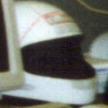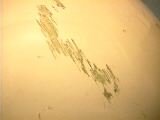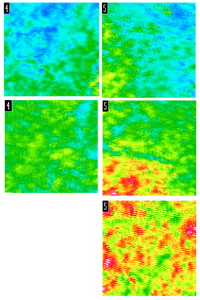

Visible Scratch Marks
on the Helmet Surface


C-Scan Image of
the Helmet Shell


|
Motorcycle Helmet Studies
In this study, we correlate physical damage on the surface to internal damages sustained by motorcycle helmets involved in motorcycle accidents. About 100 helmets from actual crashes were collected for evaluation. After visual inspection and recording observable damages, we launched ultrasound through the shell, recording the arrival time and amplitude of the reflected signals. Comparing the observed surface damage to the C-scan image, we determined the extend of the surface damage spreading beneath the helmet surface. Color scales were assigned to the signal amplitude within the critical response time windows. High amplitude of the reflected signal from the interior of the shell was associated with possible delamination, while low amplitude indicated crushing or the presence of distributed damage within the shell.
|

Visible Scratch Marks
C-Scan Image of
|
 |
 Northridge Earthquake Injury Study The 1994 Northridge earthquake led to severe structural damage to more than 10,000 buildings, killing 58 and injuring 138 persons in the Los Angeles City. It is often assumed that death and injuries are mainly caused by building collapse and structural failure. However, no systematic studies have been made to verify this. With Dr. Jess Kraus of UCLA's School of Public Health, we studied the existence of any possible correlation between the fatal and non-fatal injuries and the structural damages that occurred during the Northridge quake and mapped them. A extremely detailed profile was generated to establish a database, and then an overall analysis was performed.
|
 
Location of Structural Damage
|
 |
 
Free Body Diagrams of
|
 A Biomechanical Study of Lower Extremity Fractures in Motorcycle Crashes The objective of this study is to explore, from an injury biomechanics approach, the relationship between type of crash and the modality and severity of lower extremity fracture. Our initial aim is to determine, epidemiologically, the fracture pattern among lower leg injured motorcycle riders. Our goal in this aim is to identify any predominant fracture pattern according to fracture site, bone combination, multiple breaks, or fracture line to look for evidence of tensile, compressive, torsional or combined stresses. The analysis of crash is based on a database compiled by the Southern California Injury Prevention Research Center (SCIPRC) which includes 3,720 cases of motorcycle crash injuries throughout the state of California for 1991 and 1992. Data are drawn from 28 participating hospitals, 11 coroner's offices and numerous police departments. There were 21,192 injuries for the 3,720 cases. |
